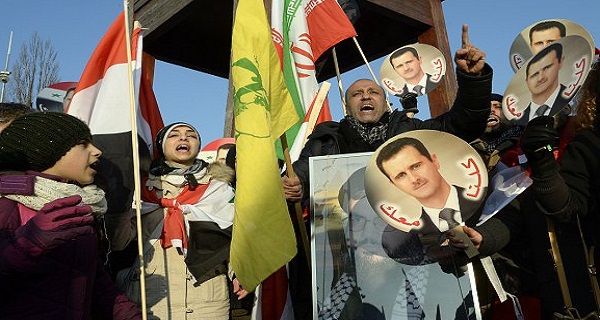Hezbollah’s vulnerability in Syria: Open exposure to many enemies
Joyce Karam/Al Arabiya/May 17/16
As the guessing game continues on how and who might have killed Hezbollah’s enigmatic military leader Mustafa Baddredine in Syria last week, the series of hypothesis around his death illustrate the party’s biggest vulnerability in the conflict: operating in plain sight and in the midst of enemies.
Hezbollah’s involvement in the Syrian war officially entered its fourth year this month, and while the party talks routinely about the military expertise and strategic territorial gains it has secured in the conflict, Syria has also been a costly undertaking for the party on the military, intelligence and financial fronts.
From Ayoub to Baddredine
Hezbollah does not declare its casualties in the conflict, but estimates point out to a figure between 800 and 1000 losses since 2013 in Syria. Such number stands out as being relatively high when contrasted with Hezbollah’s losses of 1361 fighters in its whole three-decade-long war against Israel including the July 2006 war (68 total).
But beyond the toll on its foot soldiers, recruits and finances, Syria’s most costly burden on Hezbollah has been the losses in its senior ranking leadership and key operational strategists in the party. From Fawzi Ayoub in 2014 to Baddredine in 2016, Hezbollah has lost 10 senior leaders in the Syrian war, among them names that have been associated with party’s ideological rise and struggle such as Samir Kuntar and Jihad Imad Moughniyeh both killed in 2015.
The losses in Hezbollah senior ranks highlight the battle and security challenges that have accompanied its Syria involvement. Fighting away from its home base, and against the local population, the Syrian war is bringing forth a set of vulnerabilities to Hezbollah, without the option of achieving its objectives or ability to withdraw in the near future.
Whatever is the conflict’s outcome and the aftermath of the Baddredine killing, Syria has already changed the image, trajectory and prowess of Hezbollah
Geographically, securing Syria against a widespread local insurgency is proving to be an unpractical and ambitious task for Hezbollah, Iran and the Assad regime. Both Samir Kuntar and Baddredine were killed in Damascus, inside what Hezbollah and Assad assumed to be a secure enclave. However, battles between the regime and the rebels have gone on for years in Damascus suburbs, at a proximity of 20-30 km from where Baddredine was allegedly killed.
Even in the best case scenario for the Assad regime if it takes control of all of the Damascus suburbs (something it has failed to do in the last four years), the Syrian capital will never be as secure of a fortress for Hezbollah as is Beirut’s Dahiye. The Lebanese armed group does not have the power controls or local support in Syria that it enjoys within the intelligence, military and security structures inside Lebanon. This creates a major vulnerability and dilemma for Hezbollah in dispatching a senior leader such as Badreddine to a war zone where he was operationally needed but under greater threat.
Additionally, the cost of taking out Baddredine in an open and protracted war like the one that Hezbollah is involved in inside Syria is much lower than reigniting the Lebanese front, that has been fairly stable since 2006. More importantly, the complexity and multiple layers of the Syrian conflict, the divides sometimes within the regime and the rebel camps, as well as the involvement of multiple regional actors, make intelligence breaches and infiltrations all the more likely.
Hezbollah’s many enemies
In Syria, Hezbollah is confronted by a very long list of enemies, even longer than that challenging the Assad regime who maintains its own intelligence structure and base of supporters. The same cannot be said about Hezbollah who is fighting on a foreign turf and has to rely on the regime for logistical and intelligence support especially in areas far from the Lebanese border. Today, the Syrian rebels, Jabhat Nusra, ISIS, Israeli, Turkish, Arab, European and US intelligence are all are present in Syria and have a stake in taking out Baddredine.
Theories of infiltration within Hezbollah have also surfaced after the Baderddine killing. The Independent reported that “more than one mourner at Badreddine’s funeral voiced suspicion that Hezbollah has been infiltrated by spies.”
This is a possibility given that Baddredine and Kuntar are not the type of fighters that Hezbollah would send alone to the battlefront. They operate under very tight security, surrounded by bodyguards, and with no media exposure. The many narratives from pro-Hezbollah media that followed the Baddredine assassination, blaming Israel then the “Takfiris”, reflect the sense of disarray following the operation, and the intelligence blow it represents in going after the party.
Today, Hezbollah’s dilemma in Syria is in what it sees as a strategic battle to fight despite the rising cost and exposure to its enemies. The Syrian landscape and nature of the conflict are helping Hezbollah grow and expand territorial control, but the party is also more laid bare to its rivals, trying to balance out its losses and its interests in the longer run in Syria.
There is a sense of irony in Hezbollah’s involvement in Syria, in that the party that largely chose to stay away from the Lebanese war for 15 years has engulfed itself in a vicious circle of proxy, internal and very costly conflict outside its home turf. Whatever is the conflict’s outcome and the aftermath of the Baddredine killing, Syria has already changed the image, trajectory and prowess of Hezbollah.





















